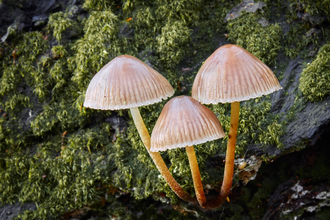
Sue Steward / New Leaf Images
Kenilworth Common
Location
Know before you go
Dogs
When to visit
Opening times
Open at all timesBest time to visit
Spring and AutumnAbout the reserve
Now a Local Nature Reserve, Kenilworth Common has a long history traced back to its creation in 1756. Back then it offered rough grazing land and was covered with heathland and acidic grassland. There were no more grazing cattle after the 1800's and oak and birch trees moved in, creating the woodland we enjoy today.
What's it like to visit?
Finham Brook babbles along the southern edge of the reserve. The brook provides a rich fishing ground for the spectacular kingfisher, and a population of brown trout lurk in its shady waters. Split by the Coventry to Leamington Spa railway, the reserve still has remnants of heathland, which is now a rare habitat in Warwickshire. There's bracken and wavy hair-grass with broom and heath bedstraw all further reminders of a habitat once common locally.
Gorse and heather grow outside the reserve on undisturbed slopes where slow-worm and common lizard have been observed. This reserve brings a delight with every season. Spring flowers colour the woodland floor and summer welcomes fairytale glow-worms. In autumn a range of fungi appear including amethyst deceiver, ugly milkcap and fly agaric, whilst a crisp winter visit provides clear viewing of colourful finches, tits and jays.
What is there to do here?
- Try our brass rubbing trails
- Spot kingfishers flitting across Finham Brook
- Identify summer woodland wildlife
- Become a fungi detective in autumn
Have fun while exploring our reserve - try our brass rubbing trails!
There are two routes to follow, both starting just off Common Lane. Why not take a crayon and paper and collect all 11 species?
The red trail (5 waymarker posts) starts the the very bottom of hill. From the woodpecker starter post, the trail follows path along the brook and loops back on itself once you reach the glow worm post, exploring the eastern part of the reserve, sometimes referred to as the "Little" or "Lower" common.
The blue trail (6 waymarker posts) starts at the top of the hill with the Oak Tree starter post and takes in the larger, western part, of the reserve.
The Coventry to Leamington Railway and the Greenway separates the two parts of the common. Cycling is permitted on the Greenway only.
Done a brass rubbing on our trail? Please tweet or Facebook us with a picture!
Thanks to Warwick District Council for funding the brass rubbing trail here. If you enjoyed it try the trails at Crackley Wood and Oakley Wood.
Love wildlife? Become a member and make a difference on your doorstep
As a member, your subscription will help look after local wildlife and our amazing nature reserves across Coventry, Warwickshire and Solihull. You'll receive a range of benefits, including free entry to over 65 local nature reserves, with member only free car parks where available, and our Wild Warwickshire magazine three times a year.
Habitat
Contact us
Location map

Whitacre Heath
Whitacre Heath is a great place to explore different habitats, from open water through to marsh and the wet woodland, which supports a…

Clowes Wood & New Fallings Coppice
An ancient woodland with a mix of trees, shrubs, streams, pond, a small meadow and a precious remnant of heathland.

Bubbenhall Wood & Meadow
Bubbenhall Wood and Meadow nature reserve is nestled in the heart of the Dunsmore Living Landscape. Enjoy the contrast of ancient…






